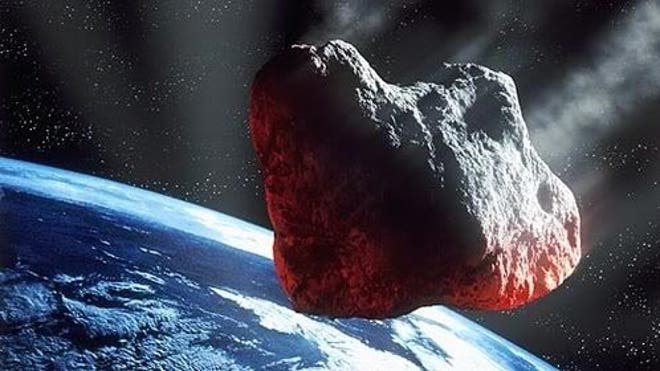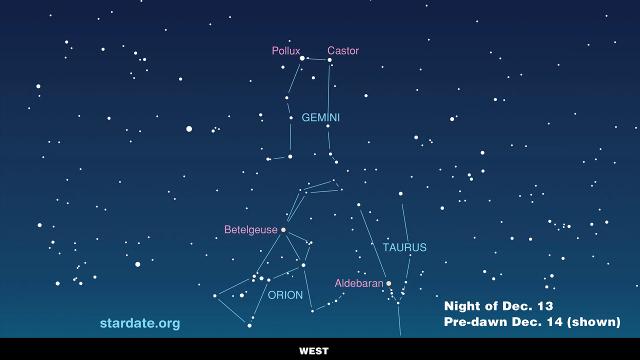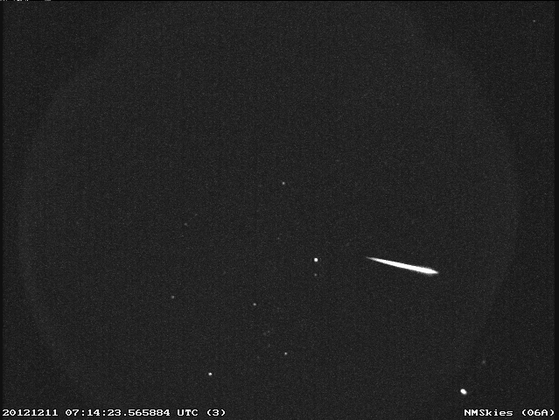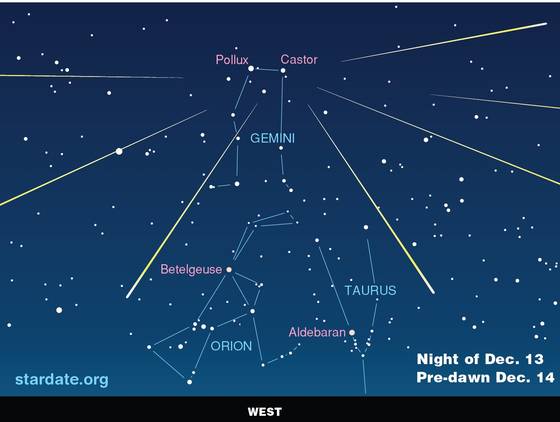Results 1 to 4 of 4
Thread Information
Users Browsing this Thread
There are currently 1 users browsing this thread. (0 members and 1 guests)
-
12-11-2012, 05:18 PM #1
3-mile-wide asteroid to buzz planet Earth tonight
3-mile-wide asteroid to buzz planet Earth tonight
By Mike Wall
Published December 11, 2012
Space.com

An artist's illustration of a large asteroid headed for Earth. (ESA)
Computer-generated views of asteroid 4179 Toutatis, constructed using radar observations from NASA's Goldstone Observatory in California. (NASA)
Next SlidePrevious Slide
A giant asteroid will make a flyby of Earth over the next few days, and armchair astronomers can watch the action live on their computers.
The near-Earth asteroid 4179 Toutatis , which is about 3 miles wide, will zoom within 4.3 million miles of Earth during its closest approach early Wednesday morning, Dec. 12. That's too far away to pose any impact threat on this pass, but close enough to put on a pretty good show through top-notch telescopes, researchers say.
, which is about 3 miles wide, will zoom within 4.3 million miles of Earth during its closest approach early Wednesday morning, Dec. 12. That's too far away to pose any impact threat on this pass, but close enough to put on a pretty good show through top-notch telescopes, researchers say.
And some of those scopes will be tracking Toutatis' movements for the benefit of skywatchers around the world. The online Slooh Space Camera and Virtual Telescope Project, for example, will both stream live, free footage of the asteroid from professional-quality observatories.
from professional-quality observatories.
Slooh will webcast Toutatis views from a scope in the Canary Islands off the west coast of Africa beginning at 3 p.m. EST (2000 GMT) Dec. 11. Another show will follow at 10 p.m. EST tonight (0300 GMT Wednesday), with footage from an instrument in Arizona. You can watch them at Slooh's website: http://www.slooh.com.
Both shows will feature commentary from Slooh president Patrick Paolucci and Astronomy Magazine columnist Bob Berman. [Photos: Asteroids in Deep Space ]
]
"Slooh technical staff will let the public follow this fast-moving asteroid in two different ways. In one view, the background stars will be tracked at their own rate and the asteroid will appear as an obvious streak or a moving time-lapse dot across the starry field," Berman said in a statement.
"In a second view, Toutatis itself will be tracked and held steady as a tiny pointlike object, while Earth's spin makes the background stars whiz by as streaks," Berman added. "Both methods will make the asteroid's speedy orbital motion obvious as it passes us in space."
Meanwhile, the Virtual Telescope Project — which is run by Gianluca Masi of Bellatrix Astronomical Observatory in Italy — will offer its own free webcast Thursday at 3 p.m. EST (2000 GMT), complete with commentary from astrophysicists.
You can see that video stream here: The Virtual Telescope Project 2.0: Virtual Telescope’s WebTV
Asteroid Toutatis was first viewed in 1934, then officially discovered in 1989. It makes one trip around the sun every four years.
The Minor Planet Center in Cambridge, Mass., lists Toutatis as a potentially hazardous object, meaning that it could pose a threat to our planet at some point in the future. The current flyby is no cause for concern, however. At its closest approach, which comes at 1:40 a.m. (0640 GMT) Wednesday, Toutatis will still be 18 times farther away from Earth than the moon is.
Toutatis would cause catastrophic damage if it ever did slam into Earth. In general, scientists think a strike by anything at least 0.6 miles wide could have global consequences, most likely by altering the world's climate for many years to come.
For comparison, the asteroid thought to have wiped out the dinosaurs 65 million years ago was an estimated 6 miles across.
3-mile-wide asteroid to buzz planet Earth tonight | Fox NewsNO AMNESTY
Don't reward the criminal actions of millions of illegal aliens by giving them citizenship.
Sign in and post comments here.
Please support our fight against illegal immigration by joining ALIPAC's email alerts here https://eepurl.com/cktGTn
-
12-12-2012, 12:09 AM #2
Big welcome to the many visitors here at ALIPAC reading this article tonight. If you are interested in helping us fight to stop and reverse the deadly and costly illegal alien invasion of America, please join our email alerts using the box on the left!
William Gheen
President of Americans for Legal Immigration PAC (ALIPAC)
www.alipac.usJoin our efforts to Secure America's Borders and End Illegal Immigration by Joining ALIPAC's E-Mail Alerts network (CLICK HERE)
-
12-12-2012, 05:55 AM #3
Asteroid passes inside moon's orbit, buzzes Earth

A screenshot showing one day of the orbit diagram for near-Earth asteroid 2012 XE54, which passed within the moon's orbit on Dec. 11, 2012. / NASA/JPL-CALTECH
A newfound asteroid gave Earth a close shave early today, zipping between our planet and the moon just two days after astronomers first spotted it.
The near-Earth asteroid 2012 XE54, which was discovered Sunday (Dec. 9), came within 140,000 miles of our planet at about 5 a.m. EST Tuesday (Dec. 11), researchers said. For comparison, the moon orbits Earth at an average distance of 240,000 miles or so.
Astronomers estimate that 2012 XE54 is about 120 feet wide — big enough to cause substantial damage if it slams into Earth someday. An object of similar size flattened 800 square miles of forest when it exploded above Siberia's Podkamennaya Tunguska River in 1908.
Asteroid 2012 XE54 also passed through Earth's shadow a few hours before its closest approach, generating an eclipse on the space rock's surface, researchers said. [Video: Asteroid 2012 XE54 Flies Closer Than Moon]
"Asteroids eclipsing during an Earth flyby are relatively rare," astronomer Pasquale Tricarico, of the Planetary Science Institute in Tucson, Ariz., wrote in a blog post Monday (Dec. 10).
The first known case, Tricarico added, was "asteroid 2008 TC3 which was totally eclipsed just one hour before entering Earth's atmosphere over Sudan in 2008, and asteroid 2012 KT42 experiencing both an eclipse and a transit during the same Earth flyby in 2012."
2012 XE54 will be coming back to Earth's neighborhood before too much longer. The asteroid completes one lap around the sun every 2.72 years.
Scientists have discovered about 9,000 near-Earth asteroids to date, but perhaps a million or more such space rocks are thought to exist.
And some of them are potentially dangerous. Observations by NASA's WISE space telescope suggest that about 4,700 asteroids at least 330 feet wide come uncomfortably close to our planet at some point in their orbits.
So far, researchers have spotted less than 30 percent of these large space rocks, which could obliterate an area the size of a state if they slammed into Earth.
But there are much bigger asteroids out there, such as 4179 Toutatis, a 3-mile-wide behemoth that's in the process of flying by Earth now. Toutatis will remain 4.3 million miles away during its closest approach Wednesday morning, but it may come closer on future passes.
Toutatis would inflict devastating damage if it slammed into Earth, perhaps extinguishing human civilization. The asteroid thought to have killed off the dinosaurs 65 million years ago was about 6 miles wide, researchers say.
Asteroid passes inside moon's orbit, buzzes Earth - CBS News
Support our FIGHT AGAINST illegal immigration & Amnesty by joining our E-mail Alerts at https://eepurl.com/cktGTn
-
12-12-2012, 02:33 PM #4
BIG BUILDUP TO THE END OF THE WORLD ON THE 21ST.?

Meteor shower -- or two-- Thursday night

Elizabeth Weise, USA TODAY
Thursday night will see a real celestial show as the Geminid meteor shower, one of the two biggest of the year, sprinkles the night sky with falling stars.

A early meteor from the Geminid meteor shower, taken by astronomers at NASA's Marshall Space Flight Center in Huntsville, Ala. on Dec. 11, 2012.(Photo: NASA Marshall Space Flight Center)
6:57AM EST December 12. 2012 - Eat your hearts out, Christmas lights. Thursday night will see a real celestial show as the Geminid meteor shower, one of the two biggest of the year, sprinkles the night sky with falling stars.
And a Russian astronomer is predicting a whole new meteor shower might happen at the same time, giving sky-watchers a double dose of thrills.
"The Geminids are one of the best performers among the meteor showers of the year," says Mark Hammergren, an astronomer at the Adler Planetarium in Chicago.
As many as 100 shooting stars an hour are possible.
The show should start just after sunset local time across North America and continue until dawn. "Meteors will appears in every part of the sky," says Alan MacRobert, a senior editor with Sky & Telescope magazine.
The shower is named for the constellation Gemini because it looks as if the meteors radiate out from it, although they don't.
 The Geminid meteor shower will appear to viewers on Earth to be coming from the constellation Gemini. It will be at its best after dark on Thursday, December 13, and before dawn on Friday, December 14.(Photo: StarDate.org, the MacDonald Observatory)
The Geminid meteor shower will appear to viewers on Earth to be coming from the constellation Gemini. It will be at its best after dark on Thursday, December 13, and before dawn on Friday, December 14.(Photo: StarDate.org, the MacDonald Observatory)
The Geminids are "right at the top or near the top of most people's lists of meteor showers," Hammergren says.
The second shower comes from a comet named Wirtanen, discovered in 1948, which may cause a new meteor shower.
Meteors are the debris trail of comets, which leave behind bits of ice and rock dust as they swing near the sun on their long, elliptical orbits. The shooting stars appear when that dust and ice burn up in Earth's atmosphere.
Wirtanen takes 5.4 years to orbit the sun. It has come close to Earth's orbit many times, but the Earth has never before run through its debris stream. However, computer models run by Russian forecaster Mikhail Maslov predict it could happen Wednesday or Thursday.
Astronomers haven't yet named the new shower because they don't know if it will produce meteors.
"Dust from this comet hitting Earth's atmosphere could produce as many as 30 meteors per hour," says Bill Cooke of NASA's Meteoroid Environment Office.
"Meteors from the new shower, if any, will be visible in the early evening, with the Geminids making their appearance later on and lasting until dawn," he says.
Maslov's model predicts that they will move slower than the Geminids.
For the Geminids, those who brave the cold and find a dark area to watch from should be rewarded with "one or two meteors a minute," MacRobert says. Even in a suburb or brightly lit city, "you might see one every couple of minutes."
The Geminids peak Thursday night into Friday morning, but they'll be visible in lesser numbers as late as Friday night.
Weatherwise, much of the country will have clear skies and seasonably cool temperatures Thursday night. The best areas for viewing the meteor shower will be the Northeast, the Mid-Atlantic, the Midwest, the Plains and the interior Southeast, according to AccuWeather meteorologist Mark Paquette.
The West might be the worst for seeing the shooting stars, Paquette says, because much of the West Coast from the Pacific Northwest down to California will be mostly cloudy with some rain possible. Other likely cloudy spots: southern Texas and the Southeast coast.
If skies are clear, there will be a bonus with this meteor shower: a new moon, so the darker sky will make the meteors easier to see. Paquette says the best time for viewing will be shortly after twilight. Look to the east or northeast to see the most meteors.
The key to seeing the Geminids is to suit up in warm clothes and prepare to spend some serious time outside in the dark.
"It's not going to do any good to go out to your front porch and just look up for a few minutes," Hammergren says.
The eye needs up to 20 minutes to adjust to night vision, he says. Find a dark area away from lights, if possible, and avoid looking at any lights. If you can't get away from city lights, Hammergren says, "at least find a shadowed place that has a wide open view of the sky and doesn't have any light actually glaring into your eye."
The origins of the Geminids is not well understood. Most meteor showers come from icy comets, but these appear to spring from an odd, rocky object named Phaeton after the son of the Greek sun god Helios.
"It's a new type of object that astronomers are talking about," says Rick Kline of Cornell University's Astronomy Department. "It's still something of a mystery."
Meteor shower -- or two-- Thursday nightNO AMNESTY
Don't reward the criminal actions of millions of illegal aliens by giving them citizenship.
Sign in and post comments here.
Please support our fight against illegal immigration by joining ALIPAC's email alerts here https://eepurl.com/cktGTn


 LinkBack URL
LinkBack URL About LinkBacks
About LinkBacks




 Reply With Quote
Reply With Quote


Student suspended for using term ‘illegal alien’ in English class
04-16-2024, 01:30 PM in General Discussion